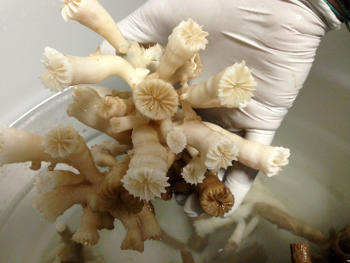Using AI to control energy for indoor agriculture
30 September 2024
Published online 15 October 2015
The very existence of deep-sea corals in their extreme Red sea environments opens new horizons for research.
A deep sea coral of the family Caryophylliidae after
collection during a Red Sea cruise in December 2011
© Christian R Voolstra
Despite a sighting of coral skeletons by Austrian zoologist Eric Marenzeller more than a century ago, the warmer, saltier waters of the Red Sea have generally been considered inhospitable to corals. But marine biologist Christian Voolstra at the King Abdullah University of Science and Technology (KAUST) offers a different perspective.
In December 2011, Voolstra’s team followed up on Marenzeller's observation, with the benefit of technological developments improving access to deep-water sites. Using a remotely operated vehicle and a submarine to sample depths of 200-800m, they found six deep-sea coral species at four sites in the Red Sea, including two new species and one known to exist in cold waters elsewhere. The other three species were observed but not collected for analysis.
“The Red Sea is a very warm environment without a lot of the processes that deep-sea organisms rely upon,” explains Voolstra. “People pretty much assumed they couldn’t exist.”
Marine researchers have reported that his findings overturned their assumptions about how deep-sea corals work and have since accumulated increasing evidence about the surprising physiological flexibility which enables deep-sea and shallow-water corals to tolerate the higher temperatures and salinities found across the Red Sea water basin.
For example, a recent study investigated the cosmopolitan shallow-water coral species Pocillopora verrucosa, which grows in a range of temperatures along latitudes from the north to the south of the Red Sea1. In another study, a globally distributed deep-sea coral species from the Red Sea, Eguchipsammia fistula, was shown to tolerate a range of physiological conditions, which may partially explain its widespread presence2.
These coral species can serve as a model for the effects of oceanic warming resulting from climate change. Researchers hope that understanding how they adapted will instruct management policies and decisions elsewhere.
Corals have a longstanding reputation as static organisms with poor prospects in the face of climate change, but Voolstra's work has helped reverse this misconception. “Corals are very successful evolutionarily. They've been here for the last 250 million years,” he explains. “Many other animals and plants died out in that time, so they must have found a way to adapt.”
Ecosystems are capable of adjusting, but you need enough genetic variation to select from.
One of the underlying factors to their adaptability may be the symbiotic relationship corals have with the algae within their cells. Shallow-water corals get the bulk of their energy from these photosynthetic algae and together they constitute a 'metaorganism'. The KAUST team discovered that different algae were associated with coral species in different environments, though they have yet to clearly demonstrate a functional link between the symbiont and the corals' plasticity.
The importance of symbiotic microorganisms has become increasingly clear in the past decade. Biologists have discovered that symbiotic bacteria, fungi, and protists living with or within plants and animals, known as the microbiome, are intimately involved in a variety of processes, from metabolism to immunity. The microbiome extends the host’s capabilities until the line between the symbiotic partners blurs.
Like other animals, corals are hosts to a microbiome, which Voolstra's team found is less structured and more diverse in corals from poorer habitats than those in more favourable environments3.
Together, the coral, the photosynthetic algae, and the microbiome form a symbiotic triumvirate called the coral holobiont.
This may explain how corals can quickly adapt to change despite their long generation time. Rather than relying on a beneficial mutation to spread by selection, coral populations might rapidly adjust by changing their associated microorganisms to alter the holobiont’s physiological capacity.
In addition, the shorter lifespans of algae and bacteria mean beneficial mutations can spread in days rather than decades. As a result, the coral metaorganism adapts and evolves much more rapidly than the coral animal partner would by itself.

© Christina R Voolstra
So far, his results have come from the 'natural experiment' run in the Red Sea, which Voolstra calls “a huge test tube for coral evolution”, but now he is turning to evolutionary experiments. By growing corals together with other organisms in aquariums and varying conditions such as pH and temperature, the team hopes to find out whether the algae and bacteria change in response to environmental pressure.
“The next big project is to establish a model system for corals, because they’re notoriously difficult to keep alive outside a reef, so there are a lot of things you simply cannot do with them,” explains Voolstra. Researchers have looked to Aiptasia, a sea anemone that forms symbiotic relationships with the same photosynthetic algae. By sequencing its genome and building an array of genetic and genomic tools, they hope to develop it as a viable model organism for studying the coral metaorganism.
In addition to providing a habitat for thousands of species, the reefs also serve as nurseries for fisheries. “It's very important to understand coral animals and how they work, not only from a biodiversity perspective, but also from the viewpoint of human nutrition,” says Voolstra.
The newly discovered adaptability of corals offers some hope in the face of climate change and over-fishing. “Ecosystems are capable of adjusting, but you need enough genetic variation to select from,” says Voolstra. He advocates establishing conservation zones which are left completely untouched as a haven for diverse populations with enough genetic variation to cope with environmental changes.
“Despite all the pessimism, I think there should be space for optimism, too,” he says.
doi:10.1038/nmiddleeast.2015.193
Stay connected: